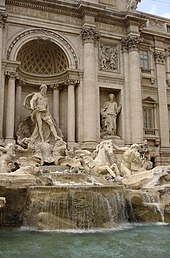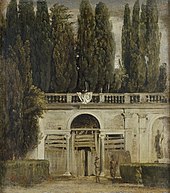Fontane di Roma
Fontane di Roma , dt. 'Fountain of Rome ', is the first of the three symphonic poems by Ottorino Respighi , which together form the Roman Trilogy . It dates from 1916. Like the other two works in the cycle , Pini di Roma (Eng. 'Pine trees of Rome') and Feste Romane (Eng. 'Roman festivals'), it is divided into four movements and is one of the most famous Compositions by the composer. The work was premiered on March 11, 1917 at the Teatro Augusteo in Rome by the Orchestra dell'Accademia Nazionale di Santa Cecilia under the direction of Antonio Guarnieri .
Sentences and programmatics
The work consists of four movements:
- La fontana di Valle Giulia all'alba (The fountain in the Valle Giulia at sunrise)
- La fontana del Tritone al mattino (The Triton Fountain in the morning)
- La fontana di Trevi al meriggio (The Trevi Fountain in the midday sun)
- La fontana di Villa Medici al tramonto (The fountain of Villa Medici at dusk)
The composer preceded the score with the following program :
“In this symphonic poem, the composer wanted to express feelings and history that were awakened in him at the sight of four Roman fountains, each time at the time of day when their peculiarities correspond most with the environment in question, or their beauty on the Makes the greatest impression on the viewer.
The first part of the poem receives his inspiration from the fountain in the Valle Giulia and paints a shepherd's landscape. Flocks of sheep pass by and lose themselves in the fresh, damp haze of a Roman dawn.Suddenly loud and continuous horns over a trilling orchestra opens the second part: the triton fountain . It is, as it were, a joyful signal call, on which the naiads and tritons hurry up in droves, chasing one another, and then performing a rampant dance in the midst of the jets of water.
A solemn theme rings out over the waves of the orchestra: the Trevi fountain at noon. The solemn theme passes from the wood to the brass and takes on a triumphant character. Fanfares sound: Neptune's chariot, pulled by seahorses, with a retinue of sirens and tritons pulls past on a shining surface of water . The procession moves away as muffled trumpets echo from afar.
The fourth part announces itself through a sad topic that rises as if over a soft splash. It is the melancholy hour of sunset. The air is full of the sound of bells, the chirping of birds and the rustling of leaves. Then all this dies gently in the silence of the night. "
occupation
Respighi wrote the work for a medium-sized romantic symphonic orchestra . He occupied the following instruments:
There are also the keyboard instruments celesta , piano and organ (ad libitum) . The striking mechanism includes a triangle , cymbals , carillon and tubular bells .
literature
- Alfred Beaujean: Fontane di Roma (Roman fountain). Symphonic poetry. In: Wulf Konold (Ed.): Lexicon Orchestermusik Romantik. Volume 2: I – R (= Series Musik Piper / Schott 8227) Schott, Mainz 1989, ISBN 3-7957-8227-9 , pp. 647-650.
- Rudolf Kloiber : Handbook of Symphonic Poetry. Breitkopf & Härtel, Wiesbaden 1967, pp. 217-220.
Web links
- Fontane di Roma : Sheet music and audio files in the International Music Score Library Project
- Fontane di Roma at Allmusic (English)


